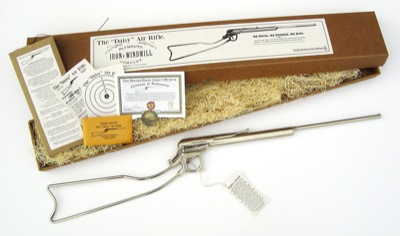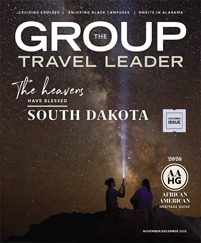
Sink your arm into a bucket of thousands of BBs for a different kind of hand massage, or brush your fingertips along the fluffy cotton balls of a centuries-old rural Mississippi River plantation.
The farms and factories of Grand Central USA offer everything from elephant shows to marble making, dog jumping and bow making.
Learning to shoot
At the Daisy Airgun Museum in Rogers, Ark., visitors can scoop out handfuls of BBs to take home in collectible tins from the museum that displays the company’s history, which dates back to the 1880s.
“We get a lot of mail from people with a picture of their whole family; all have Daisy BB guns,” said Daisy’s vice president of marketing, Joe Murfin.
The museum has displays about guns dating to the 1600s from places like Germany, England and the Czech Republic. It also includes an example of every gun the Daisy company has made.
“We also have a lot of archives and displays full of posters, magazine ads, catalogs, letters, photos, letters of agreement, a significant amount of paper goods that a lot of people like as much or more as looking at the guns,” Murfin said.
“We know there’s a lot of Daisy collectors out there, and then there’s just a lot of people that remember that they had one and how they learned how to shoot.”
The museum has an audio tour and many antiques from the Plymouth Iron Windmill Co., the original company behind Daisy. Also on display are many of the items the company made for the war effort during World War II.
Murfin said regardless of culture changes, there are a lot of good lessons kids and adults alike can learn with a BB gun.
“I could probably tell you four things I got for Christmas between the ages of 6 and 18, and one of them was a BB gun, and it was the one that I spent the most time with Dad,” Murfin said. “We shot together. There’s a bonding there. That makes the whole product very memorable.”
www.daisymuseum.com
Big yellow house
In Lakeport, Ark., the Lakeport Plantation offers a step back into history with a look at life on a cotton plantation.
“The house is still surrounded by cotton production on all sides,” said Blake Wintory, assistant director.” It feels like you’re back in time a bit. It’s a big yellow house in the middle of these fields facing the levy.”
Built in 1859 near the Mississippi River, the plantation is on the National Register of Historic Places and has been restored to display the living conditions of the day.
“We’re not just another pretty little house. The goal was to restore the house to how it was in 1860,” Wintory said. “We do know that when the house was built, the war started a year later. So we’re pretty sure most of the house was never painted inside. So the ‘unfinishedness’ of the house is part of the history.”
The house is mostly empty inside but does include some original pieces, among them a bed, washstands, a card chair, a secretary desk and a kitchen stove.
“It’s all original to the family and the descendants, and it’s old,” he said. “It’s not only history and the history of the people around here, but also a lot of history is in the materials in the house.
“I’m really fascinated about where the materials came from. We’re out in the middle of nowhere in Arkansas, but we have all of these pieces from all of over the country.”
On tours of the house, visitors learn about the plantation history and the commissary attached to the back of the house where farmers bought supplies on credit.
Holiday lights
Visiting Holiday Lighting Specialists in Tonkawa, Okla., is like Christmas in July or in any other month for that matter.
“We hand-make outdoor Christmas decorations,” said president Eric Martin. “We literally hand build from metal and hand cut, bend and weld it into shapes.”
A factory tour shows how large outdoor Christmas light displays are constructed.
“It’s the complete manufacturing process, and we take them through the entire process,” said Martin.
For people who can’t get enough of Christmas, the factory is decorated year round with Christmas lights, and visitors can shop for specialty Christmas lights.
“We have a 6,000-square-foot showroom, and people come from all over the country to purchase decorations,” said Martin.
Share the love
At the Hallmark Visitors Center in Kansas City, Mo., every day is a holiday.
“We are set up like a museum, and we have the history of Hallmark,” said Denise McAdam, reservations and scheduling specialist at the visitors center. “We just celebrated our 100th birthday last year.”
The museum includes a timeline of the company, which was founded in 1910 by Joyce C. Hall, affectionately known as Mr. J.C., who broke into the greeting card business after selling two shoeboxes full of postcards that he had purchased from a company in France.
The company is still family owned and operated, so the history has been carefully handed down through the generations.
Visitors can see demonstrations of hot-foil stamping, die cutting and the rest of the card-manufacturing process. And, with the push of a button, guests can make a bow to take home with them.
“It’s a replica of the ones we have in our manufacturing environment,” McAdam said. “It takes the ribbon and kind of twists and turns and makes a really pretty star-shaped bow, and a staple comes down and staples it, and it’s really cool.”
www.hallmarkvisitorscenter.com
Animal enthusiasts
For a visit full of cute, cuddly animals, dog shows, wagon rides and historical exhibits, visit Purina Farms in Gray Summit, Mo.
“It’s a self-guided walking tour,” said Purina Farms secretary Belinda Brown. “We have dogs, cats and farm animals. Visitors can interact with all of the animals. We also have exhibits on how to care for the animals and nutritional information.”
There are a variety of shows, including confirmation shows, obedience demonstrations and the showcasing of different breeds. There even is a Frisbee-throwing presentation with athletic dogs making high-flying leaps.
Visitors can also see an exhibition of how animal food is made.
“A lot of people come here to research the breeds, too, and get advice,” Brown said.
The visitors center incorporates a pet center, a full-size barn containing domestic farm animals, a theater and information center.
www.purina.com/purina-farms/purinafarms.aspx
Playing games
Moon Marble Co. co-owner Linda Sproules said marbles are timeless toys.
“They’re pretty, for one thing, and they’re very tactile,” she said. “The kids like that — the cool round glass is appealing. The games are fun; we teach a lot of games. And with older people, it’s kind of a connection to the past.”
Located in Bonner Springs, Kan., Moon Marble makes marbles and sells toys that are hard to find anywhere else.
“We carry all kinds of unusual toys and games, a lot of thought-provoking-type things,” Sproules said. “Hardly anything takes batteries.”
The store has regular marble-making demonstrations that show how marbles are made using a hot flame, tweezer-type tools and rods of glass that are passed back and forth over the flame while the tools shape them into a pattern.
Sproules said watching a marble-making demonstration has a soothing and mesmerizing effect.
“It sort of lulls you. We’ll have a group of folks go to a winery first and then come here,” she said with a laugh. “We have to make sure they’re still awake.”
Sproules said handmade marbles range greatly in size and design, with some elaborate marbles selling for thousands of dollars each. Lower-end marbles made in the shop start at around $20; factory-made marbles sell for less.









